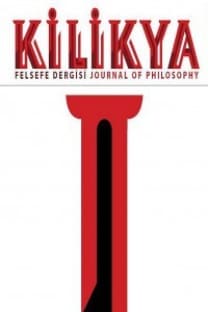Adaletin Anarşisi: Hesiodos’un Kaos’u, Anaksimender’in Apeiron’u ve Geometrik Düşünce
Kaos, Apeiron, Adalet (Dike), Sınır, Kısıtlılık
The Anarchy of Justice: Hesiod’s Chaos, Anaximander’s Apeiron, and Geometric Thought
___
- Arendt, H. (1963). On Revolution. New York: Penguin Classics.
- Aristotle (1979). Metaphysics (Hippocrates G. Apostle, Tr.). Grinnell, IA: The Peripatetic Press.
- Aristotle (1980). Physics (Hippocrates G. Apostle, Tr.). Grinnell, IA: The Peripatetic Press.
- Cornford, F. M. (1950). A Ritual Basis for Hesiod’s Theogony (1941), in The Unwritten Philosophy and Other Essays, ed. W. K. C. Guthrie (pp. 95-116). Cambridge: Cambridge University Press.
- Derrida, J. (1997). Of Grammatology (Gayatri Chakravorty Spivak, Tr.), corr. ed. Baltimore: The Johns Hopkins University Press.
- Derrida, J. (2009). The Beast and the Sovereign (Geoffrey Bennington, Tr.), eds. Michel Lisse, Marie-Louise Mallet, and Ginette Michaud, vol. 1. Chicago: The University of Chicago Press.
- Descartes, R. (1897). La Dioptrique, in Oeuvres de Descartes, eds. Charles Adam and Paul Tannery, vol. 6 (pp. 79-228). Paris: Librairie Philosophique J. Vrin.
- Descartes, R. (2001a). Geometry, in Discourse on Method, Optics, Geometry, and Meteorology (Paul J. Olscamp, Tr.), rev. ed. (pp. 175-259). Indianapolis, IN: Hackett Publishing Company.
- Descartes, R. (2001b). Optics, in Discourse on Method, Optics, Geometry, and Meteorology, (Paul J. Olscamp, Tr.), rev. ed. (pp. 63-173). Indianapolis, IN: Hackett Publishing Company.
- Euclid (1956). The Thirteen Books of the Elements (Sir Thomas L. Heath, Tr.), 2 ed. unabridged, vol. 1. New York: Dover Publications, Inc.
- Euclid (2008). Euclid’s Elements of Geometry: The Greek Text of J. L. Heiberg, ed. Richard Fitzpatrick. https://ia600901.us.archive.org/21/items/JL_Heiberg___EUCLIDS_ELEMENTS_OF_GEOMETRY/Elements.pdf.
- Gourgouris, S. (2013). Lessons in Secular Criticism. New York: Fordham University Press.
- Gourgouris, S. (2018). Arche, in Political Concepts: A Critical Lexicon, eds. J. M. Bernstein, Adi Ophir, and Ann Laura Stoler (pp. 1-23). New York: Fordham University Press.
- Graham, Daniel W., ed. and tr. (2010). Anaximander (Axr), in The Texts of Early Greek Philosophy: The Complete Fragments and Selected Testomonies of the Major Presocratics, Part I (pp. 45-71). Cambridge: Cambridge University Press.
- Heidegger, M. (1977). Der Spruch des Anaximander (1946), in Holzwege, in Gesamtausgabe I. Abteilung: Veröfftenlichte Schriften, 1914-1970, vol. 5 (pp. 321-373). Frankfurt am Main: Vittorio Klostermann.
- Heidegger, M. (1984). The Anaximander Fragment, in Early Greek Thinking: The Dawn of Western Philosophy (David Farrell Krell and Frank A. Capuzzi, Trs.) (pp. 13-58). New York: HarperCollins Publishers.
- Hesiod (2007). Theogony, as cited in G. S. Kirk, J. E. Raven, and M. Schofield (2007). The Presocratic Philosophers, 2 ed. (pp. 34-41). Cambridge: Cambridge University Press.
- Kahn, C. (1960). Anaximander and the Origins of Greek Cosmology. New York: Columbia University Press.
- Kant, I. (1920). Prolegomena zu einer jeden künftigen Metaphysik, die als Wissenschaft wird auftreten können. Leipzig: Verlag von Felix Meiner.
- Kant, I. (2001). Prolegomena to Any Future Metaphysics, in Prolegomena to Any Future Metaphysics and the Letter to Marcus Herz, February 1772 (James W. Ellington, Tr.), 2 ed. (pp. 1-116). Indianapolis, IN: Hackett Publishing Company.
- Karatani, K. (2017). Isonomia and the Origins of Philosophy (Joseph A. Murphy, Tr.). Durham, NC: Duke University Press.
- Kirk, G. S., J. E. Raven, and M. Schofield (2007). The Presocratic Philosophers, 2 ed. Cambridge: Cambridge University Press.
- Leibniz, G. W. (2001a). Infinite Numbers (c. 10 April 1676), in The Labyrinth of the Continuum: Writings on the Continuum Problem, 1672-1686 (Richard T. W. Arthur, Tr.) (pp. 82-101). New Haven, CT: Yale University Press.
- Leibniz, G. W. (2001b). Metaphysical Definitions and Reflection (Summer 1678-Winter 1680-81), in The Labyrinth of the Continuum: Writings on the Continuum Problem, 1672-1686 (Richard T. W. Arthur, Tr.) (pp. 236-257). New Haven, CT: Yale University Press.
- Leibniz, G. W. (2001c). On Substance, Change, Time, and Extension (Selections) (Summer 1683-Early 1685?), in The Labyrinth of the Continuum: Writings on the Continuum Problem, 1672-1686 (Richard T. W. Arthur, Tr.) (pp. 264-271). New Haven, CT: Yale University Press.
- Liddell, H. G., and R. Scott. (1940a). Anarchos, in A Greek-English Lexicon (Sir Henry Stuart Jones, Rev.). Oxford: Clarendon Press.
- Liddell, H. G., and R. Scott. (1940b). Chasko, in A Greek-English Lexicon (Sir Henry Stuart Jones, Rev.). Oxford: Clarendon Press.
- Liddell, H. G., and R. Scott. (1940c). Chronos, in A Greek-English Lexicon (Sir Henry Stuart Jones, Rev.). Oxford: Clarendon Press.
- Liddell, H. G., and R. Scott. (1940d). Egchronios, in A Greek-English Lexicon (Sir Henry Stuart Jones, Rev.). Oxford: Clarendon Press.
- Mondi, R. (1989). Chaos and the Hesiodic Cosmogony. Harvard Studies in Classical Philology (92), 1-41. https://www.jstor.org/stable/i213685.
- Pritzl, K., OP (2013). Anaximander’s apeiron and the Arrangement of Time, in Early Greek Philosophy: The Presocratics and the Emergence of Reason, ed. Joe McCoy (pp. 18-35). Washington, DC: Catholic University of America Press.
- Simplicius of Cilicia (1882). In Aristotelis Physicorum libros quattuor priores/posteriores, ed. Hermann Diels. Berlin: G. Reimeri.
- Stokes, M. C. (1963). Hesiodic and Milesian Cosmogonies: II. Phronesis (8) 1, 1-34. https://www.jstor.org/stable/4181712.
- Vernant, J.-P. (2006). Myth and Thought among the Greeks (Janet Lloyd and Jeff Fort, Trs.). New York: Zone Books.
- Xenophanes of Colophon (2007). As cited in G. S. Kirk, J. E. Raven, and M. Schofield (2007). The Presocratic Philosophers, 2 ed. (pp. 163-180). Cambridge: Cambridge University Press.
- Yayın Aralığı: 2
- Başlangıç: 2014
- Yayıncı: Eray Yağanak
Bireyleşim Sorunu: Aristoteles’in Bireyleşim İlkesi ve Özdeşlik
Kaybın Farklı Kipleri Üzerine Bir Deneme
Kirene Okulunda Mutluluk Ahlakının Reddi
Adaletin Anarşisi: Hesiodos’un Kaos’u, Anaksimender’in Apeiron’u ve Geometrik Düşünce
Kantçı Düşüncenin Feminist Maledilişi Olanaklı mıdır?
Wang Yangming’in “Sezgisel Bilgi” Kuramı: Eylemde Zihinsel-Spiritüel Bütünlük
Pandemiyi Olumlamak ya da Hayata Yüz Çevirmek: Nietzscheci Bir Değerlendirme
